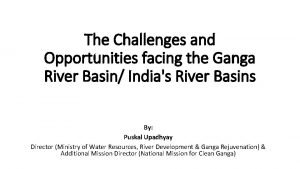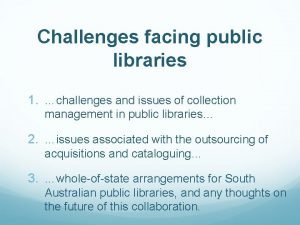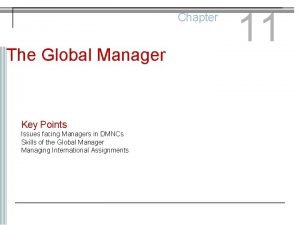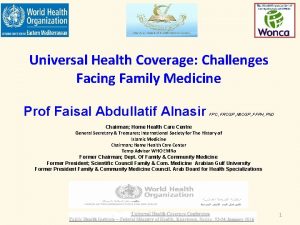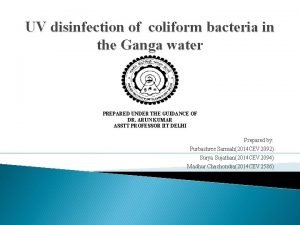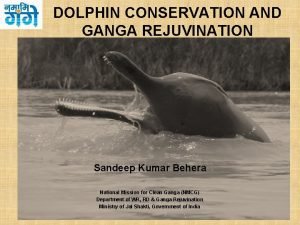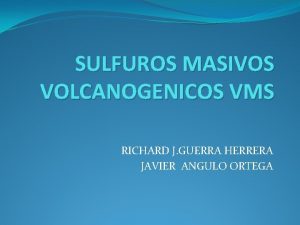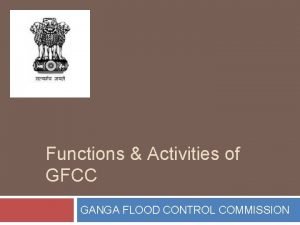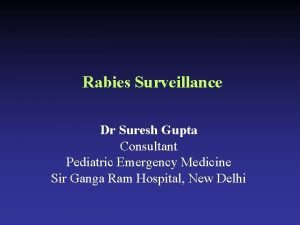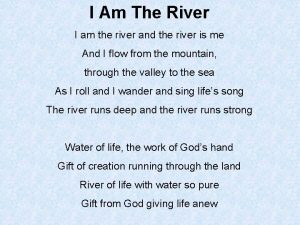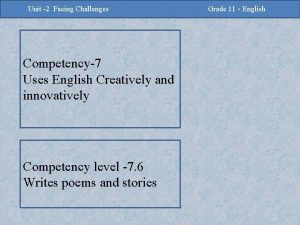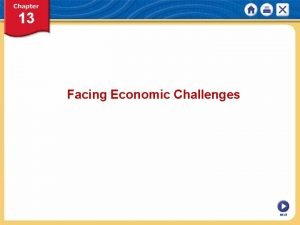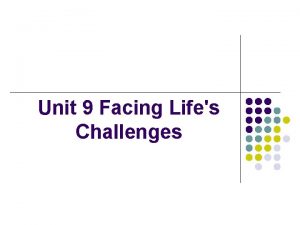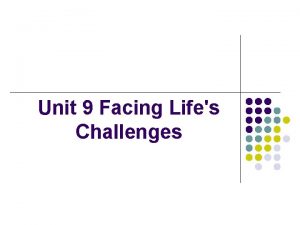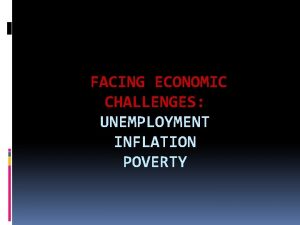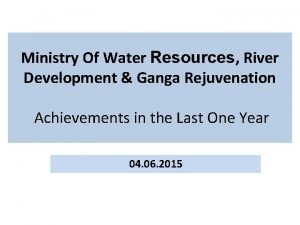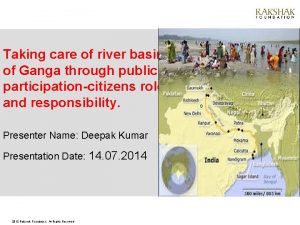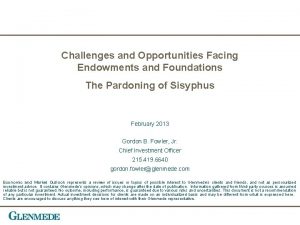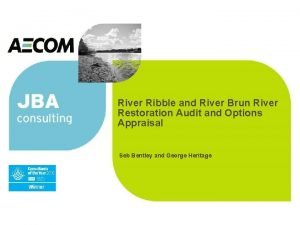The Challenges and Opportunities facing the Ganga River




















- Slides: 20

The Challenges and Opportunities facing the Ganga River Basin/ India's River Basins By: Puskal Upadhyay Director (Ministry of Water Resources, River Development & Ganga Rejuvenation) & Additional Mission Director (National Mission for Clean Ganga)

Basin Management approach Integrated Water Resources Management(IWRM) Ecosystems Management River Basin Management • • • Helps integrate various components of ecosystem Planning process becomes more comprehensive Competing demands are addressed in more rational and sustainable manner Moves from coordination based to governance based approach Problems of scale are better addressed Provides a natural base to the planning process

25 River Basins in India Ganga Basin Source: ‘River Basin Atlas of India’ (2012), Ministry of Water Resources, River Development & Ganga Rejuvenation, Government of India

Importance of Ganga Basin in India • Geographical coverage is the largest – 26% of India’s land mass • Most populated basin – hosts 43% of India’s population • Second highest average annual surface water potential – 28% of India’s total – second only to combined potential of Brahmaputra, Barack & others • 38% of India’s total estimated utilizable water comes from Ganga Basin – highest amongst all • Estimated utilizable surface water in Ganga is 48% of its total potential as compared to 4% for Brahmaputra • Total surface and groundwater storage in Ganga basin is largest – groundwater share is 64% • Nearly 40% of India’s total estimated replenishable ground water resources comes from Ganga Basin

Challenges faced by India’s River Basins Growing Population & Increasing Water Demand • The per capita availability of India in 2010 is 1, 588 m 3/year – moving towards water stress • Demand expected to increase by 38% in next 4 decades • Irrigation – largest consumer of water • Very low water use efficiency – presently 3540% • Based on a study, demand for domestic sector to grow 2. 6 times, energy 3. 7 times and industry 2. 2 times in in next 4 decades Percent contribution in Water demand (2010) Energy 3% Industries 6% Domestic 6% Irrigation 85%

Challenges faced by India’s River Basins Increase in water pollution • Partially or untreated municipal sewage – 75% of the pollution load to streams & water bodies • Estimated sewage generation in India – 62000 MLD • Treatment capacity available only for 32% of sewage generated (CPCB, 2015) • Industries contribute approximately 25% of the pollution load – highly toxic in nature • Contamination of groundwater with heavy metals– arsenic, fluoride, iron, etc contd. Drain discharging into river Ganga

Challenges faced by India’s River Basins High seasonal variations & Extreme weather events – floods/droughts • Highly seasonal rainfall– concentrated over 45 months • Huge geographical variations in rainfall across the country • One-sixth of geographical area (40 million hectares) of country is drought-prone • Around 7. 5 million hectares affected by flood • Forecasting and warning systems not efficient contd.

Challenges faced by India’s River Basins Trans- boundary water issues • Ganga-Brahmaputra-Barak basins are international river basins – management driven by agreements or treaties between riparian countries • Remaining basins are mostly inter-state • Water is a State subject – Centre only to manage in case of inter-state disputes • Multiple rights holders – States, Sectors, Individuals and Communities contd.

Challenges faced by India’s River Basins contd. Fragmented Management • • Water is a State subject Management of water by multiple institutions– CWC, CPCB, CGWB, NDWA, etc. River basin encompasses more than one State and its management require coordination between all stakeholders/departments/institutions Instead of following river-basin management, most efforts by Government to manage river were town-centric and implemented by individual States Activities in the upstream of a basin affects the downstream – cannot be managed by administrative boundaries Management will not be holistic if basin approach is not taken Most efforts have failed because of fragmented management

Need for River Basin Management: Ganga Basin “River basin is a ‘geographical unit’ enclosing an area drained by streams and channels that feed a river at a particular point. ” Ganga Basin Total Area : 8, 61, 404 km 2 Total Length : 2525 km Uttarakhand : 450 km UP : 1000 km Sharing length ( UP –Bihar) : 110 km Bihar : 405 km Jharkhand : 40 km West Bengal : 520 km

Need for River Basin Management: Ganga Basin • Ganga Basin – comprises of 11 states • Mainstem flows through 5 states • Pollution in Bihar cannot be managed until upstream states are managed • Hence efforts between States cannot be disjointed – a basin level planning is required • Ganga Action Plan (GAP) I & II successfully created 961 MLD treatment capacity but with limited visible change • Learning from GAP – A holistic river basin approach required to manage the river Ganga Bihar, 93580, 11% contd. Jharkhand, 50389, 6% Haryana, 34343, 4% H. P. , 4317, 1% Rajasthan, 112496, 13% Chattisgarh, 17907, 2% West Bengal, 71489, 8% U. P. , 241392, 28% M. P. , 181066, 21% Uttarakhand, 52988, 6% State Wise Catchment Area of River Ganga

Upper Stretch Gangotri to Haridwar Length : 294 km Characteristics: ü River flows on steep bed ü Turbulent flow with high velocities ü Centre for pilgrim tourism & spiritual activities ü Mahaseer and Trout key species Challenges: ü Disruption of natural flow due to several HEPs/ dams ü Deforestation ü Loss of native medicinal and herbal plants ü Highly sensitive and fragile ecosystem and biodiversity ü High inflow of tourists ü Retreating Glaciers

Middle Stretch Haridwar to Varanasi Length : 1082 km Characteristics: ü River enters into plains ü Wide river bed and flood plain ü Active breeding sites of turtles, crocodiles, ghariyals, gangetic dolphins, etc. ü Narora Atomic Power Plant Challenges: ü Huge quantities of water abstraction and diversion ü High degree of pollutant loads from domestic, industrial and agricultural activities ü Cluster of tanneries in Kanpur ü Ramganga and Kali – hotspot of pollution

Lower Stretch Varanasi to Ganga Sagar Length : 1134 km Characteristics: ü Heavy sediment transport and deposition ü Meandering river and frequent change in channel path ü Active breeding sites of Gangetic Dolphins, etc. ü Sunderbans - a UNESCO World Heritage Site & home to Bengal Tiger Challenges: ü Encroachment of river bed, sand mining, etc. ü Frequent floods and droughts ü Large point and non-point pollution load ü International disputes on flows and interventions

08/09/2014 Efforts Towards Ganga Conservation 15 A Shift Towards Basin Based Approach GAP II NRCP • Launched in 1985 • Focus on Main stem of River Ganga • 25 Towns Covered • 260 schemes completed • Extended from GAP I in 1993 • Merged with NRCP in 1996 • Taken up works on four tributaries – Yamuna, Gomti, Damodar & Mahananda • Launched in 1995 • Covered 41 major Rivers of the country • 8 Ganga basin rivers taken up viz Betwa, Chambal, Gang. a, Mahananda, Mandakini, Ramganga, Yamuna • • • GAP : Ganga Action Plan NRCP : National River Conservation Plan NGRBA : National Ganga River Basin Authority NMCG : National Mission for Clean Ganga SPMGs : State Program Management Groups Namami Gange NGRBA • • • Separate Authority for Ganga created in 2009 Chaired by Prime Minister of India NMCG as an implementing body at center and SPMGs at states • • • Project under Separate Ministry for Ganga Rejuvenation All 11 Basin states covered Conservation measures for all tributaries of Ganga

‘Namami Gange’ – Holistic approach Ganga River Basin Management Plan (GRBMP) by IIT Consortium Thrust Areas Pollution abatement Wholesome River Front Development Flood-plain protection & Sand. Mining Conservation of biodiversity Capacity Building and State’s participation Peoples’ participation and creating awareness Research and Monitoring Tributaries and sub-tributaries of Ganga brought under one umbrella – Holistic Basin Approach Improved Inter-Ministerial and Centre-State Co-ordination

‘Namami Gange’ – Holistic approach § Duration: 5 Years 2015 -16 to 2019 -20 § Cost (2015 -16 to 2019 -20): ₹ 20, 000 crores § Includes ongoing projects and new initiatives § Four-fold increase over the expenditure in the past 30 years contd. Municipal Sewage Management River Surface Cleaning Industrial Pollution Rural Sanitation Crematoria Connecting People with River § Primary focus on pollution abatement Water Quality Monitoring § Moving from ‘River Cleaning’ to ‘River Biodiversity Conservation Rejuvenation’ Aviral Ganga

Efforts initiated under Namami Gange 100% sewerage treatment infrastructure for 118 Towns River Front Development Strict enforcement for Industrial pollution Improved wood-based crematoria Massive Afforestation Drive River Surface Cleaning Treatment of drains

Meeting the challenge: Problem flagged at appropriate time opportunities • River Ganga is still a living river (Dissolved Oxygen meets the standard at majority of the segments) • Rejuvenation efforts initiated with launch of ‘Namami Gange’ • Dolphins, turtles, ghariyals though threatened but efforts to conserve these species are initiated National Commitment and Priority • River Ganga declared as ‘National River’ • Prime Minister announced ‘Namami Gange’ Program • Budget allocated for Ganga Rejuvenation has increased 4 fold – Rs 20, 000 Crores till 2019 -20 Existing Institutions • National Ganga River Basin Authority (NGRBA) – an apex level Authority chaired by Hon’ble PM of India • National Mission for Clean Ganga (NMCG) – implementing body of NGRBA • State Program Management Group (SPMGs) – in all 5 basin states Sharing of international experience • Successful experience of international rivers such as Rhine, Danube, Thames, Murray-Darling, etc. provides learning for Ganga Rejuvenation

Thank You
 Ganga river system map
Ganga river system map Challenges facing global managers
Challenges facing global managers Global sourcing in international business
Global sourcing in international business What are the challenges facing the church today
What are the challenges facing the church today Contemporary business world
Contemporary business world What are the major challenges facing public libraries
What are the major challenges facing public libraries Challenges facing global managers
Challenges facing global managers Challenges facing family medicine
Challenges facing family medicine Opportunities of political in media and information
Opportunities of political in media and information Greater bay area opportunities and challenges
Greater bay area opportunities and challenges Ganga uvs
Ganga uvs Dolphin/biodiversity of ganga drawing
Dolphin/biodiversity of ganga drawing Ef35lp03 atividades
Ef35lp03 atividades Mena i ganga
Mena i ganga Ganga flood control commission
Ganga flood control commission Dr suresh gupta ganga ram hospital
Dr suresh gupta ganga ram hospital Ganga engineering works
Ganga engineering works Ganga weed
Ganga weed I am the river and the river is me
I am the river and the river is me Tukwila
Tukwila Erect position in medicine
Erect position in medicine
